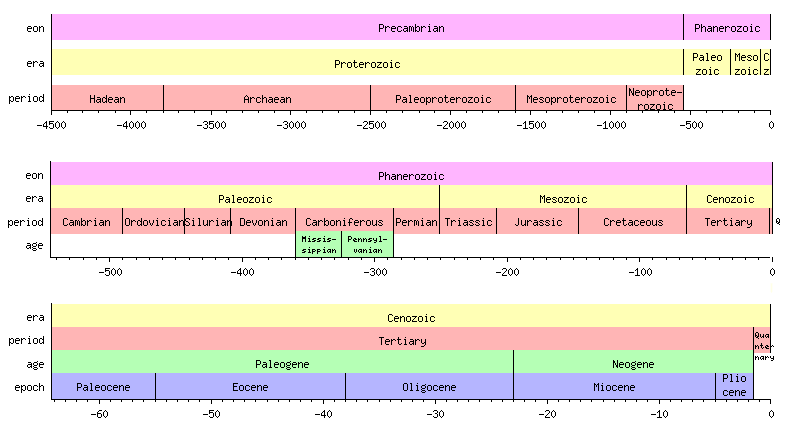| Revision as of 19:57, 26 March 2004 editErik Zachte (talk | contribs)Extended confirmed users1,999 edits graphical time chart added← Previous edit | Revision as of 22:16, 3 April 2004 edit undoDragons flight (talk | contribs)Edit filter managers, Extended confirmed users, Rollbackers, Template editors25,792 editsm Added External LinksNext edit → | ||
| Line 181: | Line 181: | ||
| * ] | * ] | ||
| * ] | * ] | ||
| ==External References== | |||
| * | |||
| * | |||
| ] ] ] ] ] ]] ] | ] ] ] ] ] ]] ] | ||
Revision as of 22:16, 3 April 2004
A timeline of geologic periods.
(not shown to scale)
| Years Ago | Epoch | Period/Age | Era | Eon | Major Events | |
|---|---|---|---|---|---|---|
| Present day | Holocene | Quaternary | Cenozoic | Phanerozoic | ||
| 10,000 | Pleistocene | Extinction of many large mammals. Evolution of fully modern humans | ||||
| 1.6 million | Pliocene | Tertiary | Neogene | |||
| 5 million | Miocene | |||||
| 23 million | Oligocene | Paleogene | ||||
| 38 million | Eocene | |||||
| 55 million | Paleocene | |||||
| 64.3 million | Cretaceous | Mesozoic | Dinosaurs reach peak, become extinct. Primitive placental mammals | |||
| 146 million | Jurassic | Marsupial mammals, first birds, first flowering plants | ||||
| 208 million | Triassic | First dinosaurs, Egg-laying mammals | ||||
| 251.1 million | Permian | Paleozoic | Permian extinction event- 95% of life on Earth becomes extinct | |||
| 286 million | Carboniferous | Pennsylvanian | Abundant insects, first reptiles, coal forests | |||
| 325 million | Mississippian | Large primitive trees | ||||
| 360 million | Devonian | First amphibians, clubmosses and horsetails appear, progymnosperms (first seed bearing plants) appear | ||||
| 408.5 million | Silurian | First land plant fossils | ||||
| 443.5 million | Ordovician | Invertebrates dominant | ||||
| 490 million | Cambrian | Major diversification of life in the Cambrian explosion | ||||
| 545 million | Neoproterozoic | Proterozoic | Precambrian | First multi-celled animals | ||
| 900 million | Mesoproterozoic | |||||
| 1,600 million | Paleoproterozoic | First Complex single-celled life | ||||
| 2,500 million | Archaean | Simple single-celled life | ||||
| 3,800 million | Hadean | 4,100 million- Oldest known rock;
4,400 million- Oldest known mineral;4,600- Formation of Earth |
||||
1) In North America, the Carboniferous is subdivided into Mississippian and Pennsylvanian Periods.
2) Discoveries in the past quarter century have substantially changed the view of geologic and paleontologic events immediately prior to the Cambrian. The nomenclature has not stabilized. The term Neoproterozoic is used here, but other writers might equally well have used one or more of the terms 'Ediacarian', 'Vendian', 'Varangian', 'Precambrian', 'Protocambrian', 'Eocambrian', or might have extended the Cambrian further back in time. All of these terms are usually treated as a subset of the Proterozoic rather than a period between the Paleozoic and the Proterozoic.
3) Dates are slightly uncertain with differences of a few percent between various sources being common. This is largely due to uncertainties in radiometric dating and the problem that deposits suitable for radiometric dating seldom occur exactly at the places in the geologic column where we would most like to have them. Dates with an * are radiometrically determined based on internationally agreed to GSSPs. All dates given are for the end of the epoch in question.
4) Paleontologists often refer to faunal stages rather than geologic Periods. The Stage Nomenclature is quite complex. See http://flatpebble.nceas.ucsb.edu/public/harland.html for an excellent time ordered list of faunal stages. Also see the article on GSSPs.
5) In common usage the Tertiary-Quaternary and Paleogene-Neogene-Quaternary Periods are treated as equivalents to the Mesozoic and Paleozoic Periods. The term 'Period|Age' (e.g. 'Neogene Period|Age') is sometimes used instead of 'Period'.
6) The time shown in the "Years Ago" column is that of the end of the Epoch in the "Epoch" column.
7) Precambrian was sometimes called Cryptozoic.
See also
- Fossils and the geological timescale
- Cosmological timeline
- Lunar geologic timescale
- Anthropocene
- Logarithmic timeline
